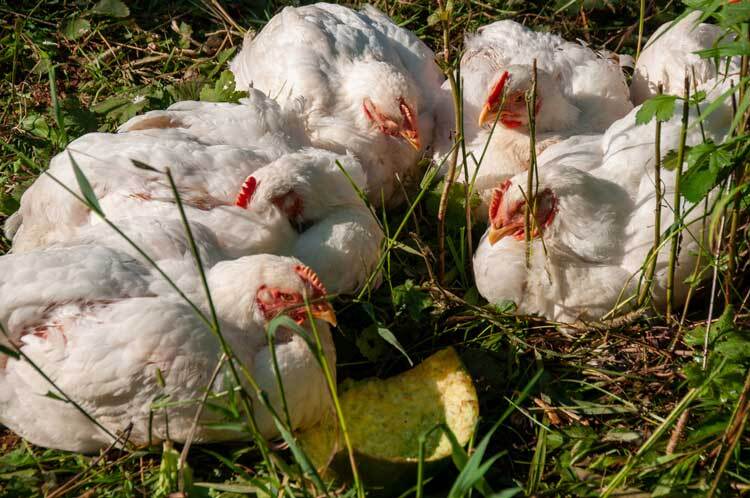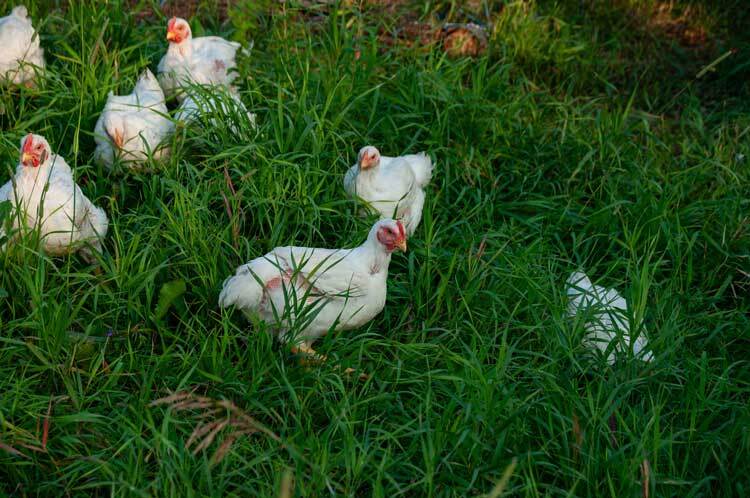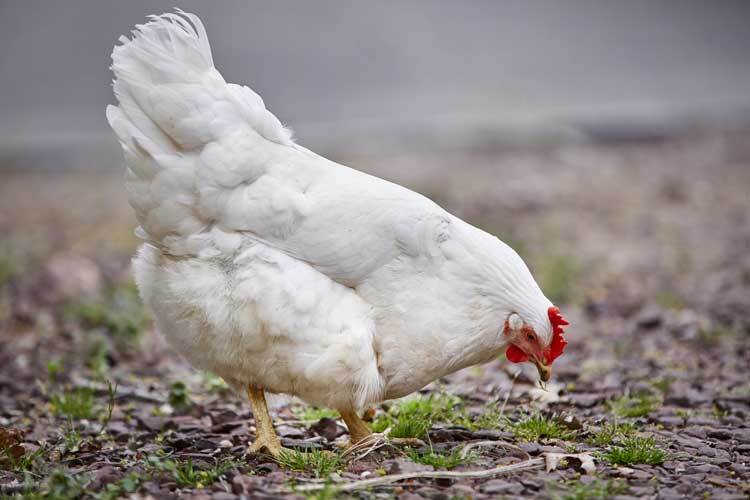The White Rock chicken breed originated in the late nineteenth century in New England. It was developed as a dual-purpose breed suitable for both meat and egg production from a mix of breeds including Dominiques, Wyandottes, and Javas.
White Rocks are a large chicken breed. They have a broad, deep body on short shanks and toes. Their defining feature is their bright white plumage accented by red comb, wattles, and earlobes. Some may exhibit a bit of straw-colored neck feathers.
These chickens have a docile and calm temperament perfect for family-friendly backyard flocks. They tend to be active foragers and do well in free-range environments. White Rocks are also excellent layers, providing a consistent supply of large brown eggs even through cold winters. Their quiet, gentle nature makes them a joy to raise.
Appearance and Physique
White Rock chickens are a handsome dual-purpose breed known for their bright white plumage accented with black or red markings. They have a single comb and medium-sized red wattles and earlobes.
- Plumage Color Patterns : White Rocks have mostly bright white feathers on their body and neck. The tail feathers can be either black or red, depending on the variety. Common feathering patterns include black tails with some black speckling on the body, or mahogany red hackle and saddle feathers contrasting the white.
- Comb and Wattle Features : White Rocks have a single comb, which stands upright on top of the head. The combs are medium in size with five distinct points or serrations. Matching red wattles hang below the comb and red earlobes on the side of the head.
- Body Size and Shape : This is a medium to large breed chicken. Roosters weigh around 9.5 pounds and hens around 7.5 pounds. They have a rectangular body shape with a broad, deep breast and straight back. Their carriage is proud and upright.
Egg Laying

White Rock chickens become sexually mature and begin laying eggs at around 16-24 weeks old. They are prolific egg layers, averaging 280 eggs per year. Some hens may lay even more, around 300 eggs annually.
The eggs are medium to large in size, averaging 55-60 grams. Shell color can range from light brown to dark brown. Some White Rocks lay eggs with speckles while others have clean, solid colored shells.
The egg production of White Rock hens peaks during the first couple years of lay. They continue laying eggs consistently but production gradually declines each year after 2-3 years old. Proper feeding and care can help maintain good egg laying rates into older age.
White Rocks are known for being excellent egg layers while also producing nice large eggs. Their high production makes them a top dual purpose breed for both eggs and meat. The brown eggs are preferred by some customers over white eggs. White Rocks are a reliable egg layer for backyard flocks or commercial operations.
Temperament
White Rock chickens are known for having a calm, docile temperament. They tend to be friendly birds that enjoy human interaction. This makes them a good option for backyard flocks, as they can be easily handled.
These chickens are not typically aggressive, even the roosters. They may exhibit some bossiness in the flock hierarchy, but are not mean-spirited. White Rocks rarely bully or pick on other chickens.
The hens have a reputation for being broody. Broodiness refers to a hen’s urge to set on a nest of eggs to hatch them. White Rock hens will often go broody several times a year. This can be seen as an advantage for those who want to hatch chicks. However, broodiness will cause a drop in egg production while the hen sets on a nest.
Overall, White Rock chickens have a calm and docile nature. Their friendly personality makes them a joy to have around. While the hens may exhibit some broody tendencies, this breed remains a good-natured addition to any flock. Their gentle temperament suits them well for families with children or as backyard pets.
Care and Feeding

White Rock chickens have some specific care and feeding requirements to ensure they stay healthy and productive.
Dietary Needs
White Rocks are heavy egg layers, so their diet should support egg production. They need a complete feed that contains 16-18% protein. This can be a commercial layer feed or a homemade mix containing grains, oats, and supplements. Calcium is especially important, so provide a supplement or oyster shell. They also need insoluble grit to help digest their food. Free choice feeding lets them eat as needed.
Amount of Feed
Give each White Rock hen about 1/4 pound of feed per day. This may vary based on their activity level. Reduce this to 1/8 pound during molting when they are not laying eggs. Always provide fresh, clean water.
Coop Considerations
White Rocks need at least 2-3 square feet of coop space each. The coop should be draft-free but well-ventilated. Provide nesting boxes for egg laying. Deep litter of shavings or straw helps keep the coop clean. Roosts should be 1-2 feet off the ground.
Exercise Requirements
These active chickens need 8-10 square feet of outdoor run space each. Allow access to the run as much as possible. They will forage for bugs and plants if allowed to free range. Rotate runs to provide fresh vegetation and reduce parasites.
With proactive care and management, White Rocks can remain healthy and productive flock members. But it’s important for owners to educate themselves on common chicken illnesses so they can catch problems early. Good prevention and hygiene practices are key to maintaining a healthy flock.
Breeding
Breeding White Rock chickens requires an understanding of their reproductive maturity and ideal pairings. This hardy dual-purpose bird reaches breeding age at around 24 weeks for pullets and 28 weeks for cockerels.
When selecting a rooster for breeding, choose one from good egg-laying stock with a large frame, bright red comb, and excellent conformation. Avoid breeding two birds that share a parent, as inbreeding can lead to issues. The ideal pairings are mating a White Rock rooster over Plymouth Rock hens or White Rock hens. This maintains hybrid vigor while passing on desirable traits like high egg production.
For best results, breed during the natural mating season in spring when egg production peaks. House one rooster with six to eight hens, and provide nest boxes for egg-laying. Fertile eggs will hatch in 21 days if properly incubated. Raise chicks on chick starter feed with adequate space and heat lamps. With good breeding practices, White Rocks will produce plenty of hardy offspring.
Chicks
Chicks are the baby chickens that hatch from fertilized White Rock eggs. The incubation period for White Rock eggs is about 21 days. Once the chicks hatch, they require special care in their first few weeks of life.
Incubation Period
The incubation period for White Rock eggs is typically 21 days. Some hatcheries recommend incubating the eggs for 22 days to ensure the chicks fully develop. The eggs should be kept at a temperature between 99-102°F and humidity around 50-55% during incubation. Turning the eggs 3-5 times per day prevents the embryo from sticking to the shell. Stop turning the eggs in the last 2-3 days to allow the chick to get into hatching position.
Care for Chicks
Newly hatched chicks need extra care and attention in their first 4-6 weeks of life. They should be kept in a brooder with a heat lamp to maintain a temperature of 95°F for the first week. Then the temperature can be reduced by 5°F each week after that. Chicks need access to clean water and a starter feed specifically formulated for chicks with at least 20% protein. The brooder should have clean litter like pine shavings and be free of drafts. Extra nutrition can be provided with dried mealworms, oats, fresh greens, and scrambled eggs. Proper sanitation and avoiding stress is key to raising healthy chicks.
Rate of Growth
White Rock chicks are a fast growing breed. They can gain about 0.25 lbs per week on average. By 6-8 weeks old, the chicks will have most of their feathers and be ready to transition to the main flock. Pullets (young females) may start laying eggs around 16-20 weeks old. White Rock roosters can reach their maximum weight of 8-9 lbs by about 18-20 weeks old. Their rapid growth means they need plenty of protein and nutrients especially in their first few months.
A Popular Choice
The White Rock chicken breed has many advantages that make it a popular choice for backyard chicken keepers and small farms.
Advantages
- Excellent egg production – White Rock hens are very productive egg layers, with some strains laying up to 280 eggs per year. They have a reputation as one of the best dual-purpose breeds for both eggs and meat.
- Good egg size : White Rock eggs are a nice large to extra large size. The brown eggs have a nice rich color and are often oversized.
- Docile temperament : This breed tends to be quite docile and friendly. They are good-natured and tolerant of children. Roosters can be a bit more aggressive though.
- Cold hardy : White Rocks handle cold climates well and continue laying through winter. Their large size gives them some extra cold tolerance.
- Disease resistant : They are quite hardy and resistant to common poultry diseases. Heat tolerance is decent too.
- Good meat production: Roosters grow large and produce a good carcass size for meat. The breed is popular for both backyard and commercial meat production.
Overall, White Rocks are an excellent dual-purpose breed with many positive attributes for small farms and backyard flocks when properly cared for. Their egg production, size, and docile temperament make them a popular breed.


